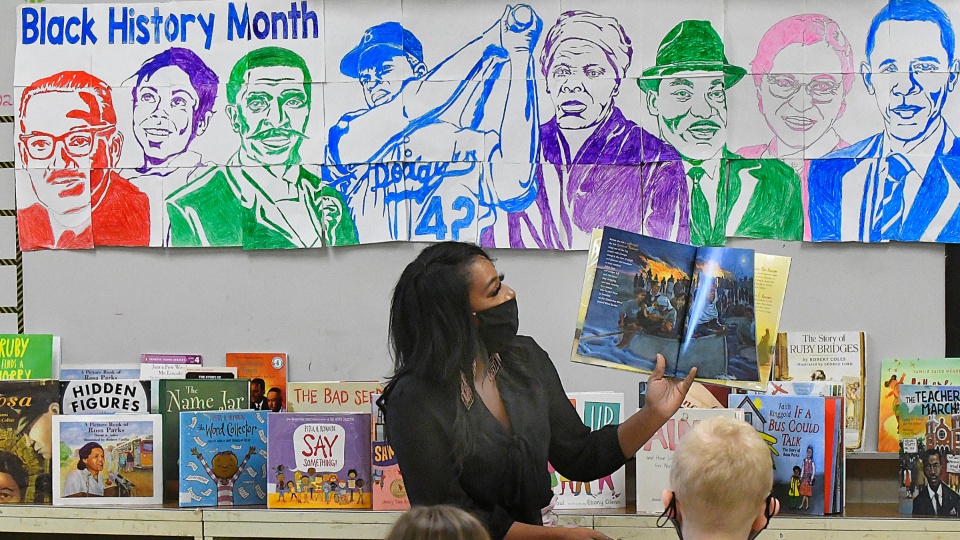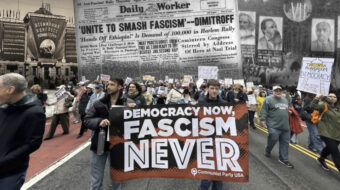
The last few years have seen a dramatic rise in attempts to erase African American history in schools. Efforts by conservative and racist politicians and activists to ban the teaching of Critical Race Theory (CRT) (a theory that examines the ways that race impacts institutions and laws); diversity, equity, and inclusion (DEI) programs in schools, government offices, and businesses; and books that discuss race and sexuality have proliferated in states like Florida, Oklahoma, and Texas, just to name a few.
Conservative lawmakers and activists claim that the banning of CRT, DEI, and books that deal with race and sexuality is crucial because they are too “woke.” As Florida Gov. Ron DeSantis noted, these materials are “pushing an agenda on our kids.”
“When you look to see they have stuff about intersectionality, abolishing prisons,” he continued, “that’s a political agenda…. We believe in education, not indoctrination.”
However, what the governor and his ideological allies are doing is endeavoring to erase the long history of racism and white supremacy in this country, a symptom of our nation’s inability to reconcile with the legacies of slavery and colonialism.
Attacking CRT, DEI, and banning books on race and sexuality is an attempt to silence critical voices of color and promote an inaccurate version of a colorblind history of the United States.
Unfortunately, efforts by white supremacists to undermine Black history are not new. In 1934, in response to white academics who were attempting to re-write the history of the Civil War as a “War of Northern Aggression” and redeem the South, Black sociologist W.E.B. DuBois called this the “propaganda of history.”
DuBois, in his book, Black Reconstruction, argued that academia, in its attempt to redeem the South, had become “devastated by passion and belief.” He further argued that the science of history is based upon establishing the “truth,” and that “we shall never have a science of history until we have in our colleges men who regard the truth as more important than the defense of the white race.”
Twenty years before DuBois wrote Black Reconstruction, historian Carter G. Woodson, who was only the second Black person, after DuBois, to gain a Ph.D. at Harvard, in 1912, recognized that he had little future in a white-dominated historical profession and that the American Historical Association had little interest in Black history.
He felt that Black contributions to U.S. history were “overlooked, ignored, and even suppressed by the writers of history textbooks and the teachers who use them.” Woodson believed it was necessary to establish an institution dedicated to the preservation of the history of Black people.
In 1915, President Woodrow Wilson, himself a historian with a Ph.D., screened the silent movie Birth of a Nation at the White House. The movie was a textbook example of the redeemers’ mythologizing of the South and the Civil War as a War of Northern Aggression. It portrayed the Union army as an army of Black men who raped white women while celebrating the rise of the Klu Klux Klan as protectors of the white race.
It was in this climate that Woodson took the steps he believed necessary to protect Black history. That same year, almost as a direct rebuttal to Wilson’s public promotion of white supremacy, Woodson established the Association for the Study of Negro Life and History in Chicago. The next year, 1916, Woodson founded the Journal of African American History.
The 1920s ushered in a new era of racial pride and cultural consciousness in Black communities. This was evident in the publication of Alain Locke’s New Negro anthology, which featured works by Black artists, poets, and scholars. Additionally, the 1920s saw the emergence of the Harlem Renaissance and increased Black radical activism. However, the 1920s was also a period of intense racial violence against Black people.
Within this climate, in 1926, Woodson established Negro History Week in the second week of February. He chose February because both Abraham Lincoln and Frederick Douglass had birthdays in February, and it was common in Black communities to celebrate both days. Woodson sought to expand the celebration of the wo men into a celebration of an entire race. However, Woodson never meant to confine the celebration of Black history to just one week or one month; he sought to expand it into a year-round continuous celebration.
Throughout the 1940s and into the ’60s, the height of de jure Jim Crow segregation in the South and de facto James Crow segregation in the North, Black communities sought to expand the teaching of Black history in their schools and communities.
By 1968, Black students and their allies were protesting across the United States for the establishment of programs that would focus on the Black experience, not just in the U.S. but around the world. These protests led to the establishment of Black Studies, Africana Studies, and African American Studies programs at universities across the nation.
In February 1976, amongst the financial austerity programs that targeted the funding of public services that would adversely affect the Black urban working class, the first official observance of Black History Month occurred when President Gerald Ford stated:
“In the Bicentennial year of our Independence, we can review with admiration the impressive contributions of black Americans to our national life…. [T]o help highlight these achievements, Dr. Carter G. Woodson founded the Association for the Study of Afro-American Life and History. We are grateful to him today for his initiative, and we are richer for the work of his organization.”
Ten years later in 1986, amongst the punitive “War on Drugs” and the rise of mass incarceration that disproportionally targeted Black communities, the U.S. Congress designated February as National Black History Month. President Ronald Reagan was compelled to issue a proclamation declaring “the foremost purpose of Black History Month is to make all Americans aware of this struggle for freedom and equal opportunity.”
Today, in 2024, as we celebrate Black History Month, it is not hard to see that the work that Black scholars like Woodson and DuBois dedicated their lives to is still a very real struggle. It is also no coincidence that Black History Month gained national and federal recognition amid periods of state repression and austerity that traumatized Black communities for generations.
Indeed, Reagan’s acknowledgement of Black History Month coincided with his establishment of Martin Luther King, Jr.’s birthday as a national holiday. Both events are scrutinized by historians as attempts by conservatives to pacify Black communities and whitewash King’s radical legacy.
Truly, Black History Month and the preservation of Black History is a tradition of resistance against Black erasure. While Black History Month is still recognized as only one month out of the year, it is now more important than ever that we carry on Woodson’s life goal of celebrating and preserving Black history year-round, year after year.
We hope you appreciated this article. At People’s World, we believe news and information should be free and accessible to all, but we need your help. Our journalism is free of corporate influence and paywalls because we are totally reader-supported. Only you, our readers and supporters, make this possible. If you enjoy reading People’s World and the stories we bring you, please support our work by donating or becoming a monthly sustainer today. Thank you!










